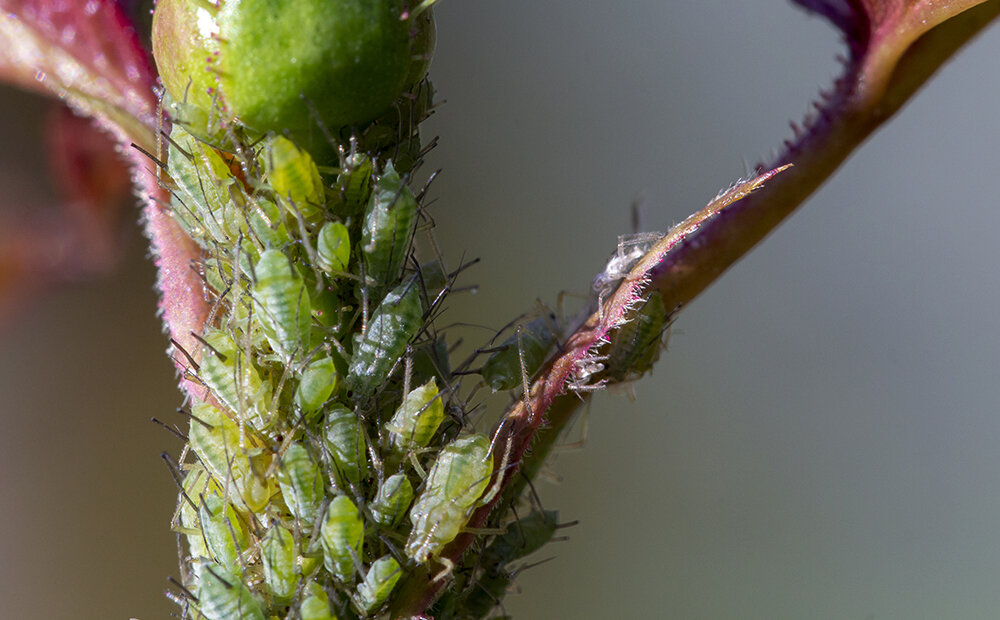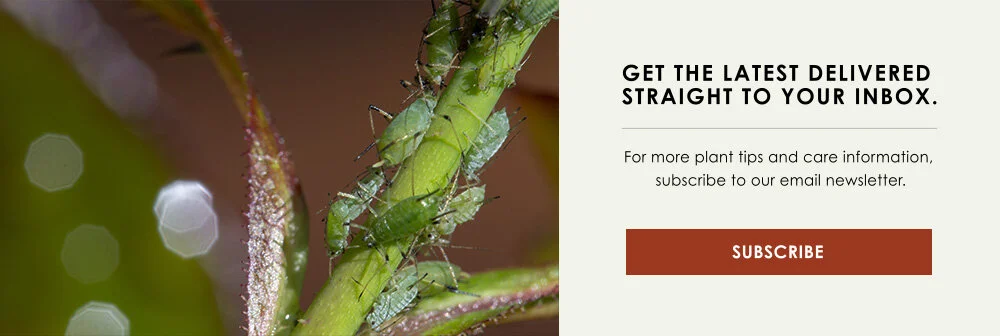HOW TO IDENTIFY APHIDS AND SAVE YOUR HOUSEPLANTS
Aphids might be one of the most annoying plant pests around. In the fall and winter, the cold drives them indoors, and we're more likely to find little green or white aphids on indoor plants around the house. Here are our best tips for controlling aphids:
APHIDS 101
Aphids reproduce in the blink of an eye and literally suck the lifeblood right out of our plants. As the weather cools off, we turn on our furnaces and the humidity drops. Our houseplants become more susceptible to these rotten little bugs when they start to dry out. Often, we see aphids in Indianapolis on plants that spent the summer outside and have been brought back in for the winter. One or two aphids can turn into a full-fledged invasion before you know it.
They can reproduce both sexually and asexually, and the females often hatch from their eggs already pregnant! Each aphid reaches adulthood in 5-7 days. Adult females can produce up to 100 offspring in a month, and when you think about how many of those offspring are pregnant females—well, that's a lot of aphids. Their exponential reproduction rate is what makes them so devastating.
WHAT DO APHIDS LOOK LIKE?
There are many different varieties of aphids, and they come in many colors, including red, brown, white, green, and even pink. The most common ones we see on houseplants are the green ones. Aphids are tiny and have pear-shaped bodies. Some aphids have wings, which allow them to fly off to invade your next plant.
WHERE WILL I FIND APHIDS?
Aphids like to congregate in places where they're relatively safe from predators and won't be seen. They'll often cluster on stems or the undersides of leaves. If you suspect you've got aphids, you'll want to inspect every plant in your house.
HOW DO I GET RID OF APHIDS?
We're sure you've heard the old saying, "an ounce of prevention is worth a pound of cure," and that certainly holds true with aphid control. Strong, healthy plants are not as susceptible to pests. As we head into winter and turn our furnaces on, remember to up your house plant watering schedule, and give them some fertilizer. The furnace dries out the air, and plants struggle more to stay hydrated, which makes them weaker and more susceptible to damage.
OFFENSIVE TACKLE TARGET: APHIDS
If you're beyond prevention and need to deal with an infestation, here's a game plan.
1. Quarantine
If you've noticed aphids on one plant, but they haven't spread to the rest yet, quarantine that plant until you're sure you've gotten rid of them.
2. Give your house plants a shower.
A great way to clear off the masses of aphids on a plant is to spray them with water. You can take your plants into the bathtub, shower, or sink. Make sure you get the underside of each leaf and the stems. In fact, showering your houseplants once or twice a year is a great habit in general for all plant parents.
If you have some really delicate houseplants that won't tolerate spray, you can bathe them by gently dunking them upside down in a bucket of room temperature water. Make sure all their leaves are submerged, and run your fingers along the stems and leaves to make sure you've removed all the aphids.
3. Apply insecticidal soap.
You can pick up insecticidal soap at our garden center, or you can make your own home remedy for aphids on indoor plants. Mix a teaspoon of liquid dish soap into a gallon of water and spray your plants liberally. Make sure to treat the undersides of leaves as well as the stems. You'll need to treat your plants several times to catch all of the aphids, so keep the spray bottle handy.
4. Apply Neem oil.
Neem oil is entirely organic and safe for your houseplants. You can pick it up at the garden center. Neem is also a fungicide, so it can be beneficial to your plants beyond just tackling aphids. There are instructions on the bottle with Neem oil, make sure to follow them carefully.
5. Apply rubbing alcohol.
If you've caught your infestation early, you may be able to take care of it with rubbing alcohol. Soak the ends of a cotton swab with alcohol, and apply it to the underside of each leaf and the stems, particularly in the spots where the leaves or branches connect to the main stem. This method is the most time-consuming, and not all plants can handle contact with rubbing alcohol. Test this remedy out on an inconspicuous area of your houseplant and wait 48 hours before attempting to treat the whole plant. If the plant leaves appear to be damaged by the alcohol, move on to another method.
6. Hang sticky traps.
You can get yellow sticky traps at the garden center. There are ones that come on hooks to hang on your plants or ones that mount on sticks. The yellow attracts bugs, so they investigate and get stuck. This solution isn't going to fix your aphid infestation, so don't rely on it as your only remedy.
7. Use a chemical spray.
If your aphid infestation is out of control, you may need to consider an insecticide spray. Sprays with pyrethrin are the safest and most effective. You'll need to spray several times over a week or two to make sure you get all of them.
KEEPING APHIDS AWAY
Once you've managed to get rid of aphids, you'll want to make sure they don't come back again, so let's get back to prevention.
Inspect your plants frequently for signs of pests.
Quarantine new house plants for a week to make sure they're not bringing any pests in.
Apply neem oil periodically, especially on plants that were previously infested.
Clean and quarantine any houseplants that were outside for the summer.
If you're on the offense for aphids right now, visit our garden center in Indianapolis as soon as possible! The quicker you can tackle them, the better. Our garden specialists can get you set up with everything you need to clear up an aphid infestation and prevent them in the future.





